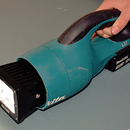Introduction: Restoring Automotive Batteries
I learnt this trick several years ago almost by accident. It works best with calcium or maintenance free batteries but the older style also works if the electrolyte level isn't below the plates. The first battery I restored came in a diesel van I bought with a blown motor, It had been sitting around for a year or so and wouldn't even turn on the ignition lights. When put on the charger it would simply not charge, and would throw up a fault condition light on the charger. The battery was restored while I fixed the engine and it is still in the van today and it starts perfectly. I'm always fixing cars and have restored another 8 batteries since then, and they all preform like new. Once you have the voltmeter and solar panel the process is free, so you have nothing to loose.
Step 1: Stuff You Will Need
You only need two Items that will cost money, a 40 watt solar panel and a voltmeter, the other two items are free, sun and time, a week to 10 days in summer or a couple of weeks in winter.
The size of the panel is important, if the panel is too big, it generates heat in the battery, and causes the electrolyte to bubble, which can damage the cells. Too small the the battery will not charge. I found a 40 watt panel perfect, although if you had a 30-60 watt panel it will still work.
Step 2: Expected Voltages
The main reason a battery charger wont charge a battery that has been left to rot, is you get some rather odd voltages when charging, so the charger either thinks the battery is charged and does nothing, or the "smart" charger will enter a fault mode. The solar panel is connected with no regulator.
What to look for..
- If you battery have a voltage of 11.5 -12.6 volt and still doesn't start your car (assuming your car has no faults) it is likely a cell has gone open circuit and this process will probably not help.
If your battery has a little hydrometer keep an eye on it, it will change colour as the battery condition improves, it a bit hard to see in the photo, but its got a bit of white in the middle, and according to the label it means "replace"
The battery photographed had a voltage of 5.69, well and truly flat and likely not going to be able to be charged with a battery charger. I have successfully restored batteries with zero volts, and one that is 12 years old
- When the solar panel is first connected, the voltage shoots up to over 18 volt this is normal, (and is something that most battery charges can't do).
- After a few minutes the voltage will come down, the photos show that after an hour the voltage is 13.33 and a few minutes later it was down to 12.99. Again a battery charger would think it was charged.
- After a day or so you may notice that the voltage has dropped down further to below 11 volts this is quite normal.
- Leave it on for a week or so and check periodically that the battery is not getting hot or bubbling (you will hear it) as this will indicate that it has a short circuited cell and is not repairable.
Step 3: When to Disconnect and Test
So you left it on for a week, how do you know if it ready? Well there is a few thing to look for.
- Eventually the voltage will rise from below 11 volts to around 13 volts and will stay there for a few days, you may notice the hydrometer change from white to black, don't disconnect yet.
- The voltage will then go up to 15- 16 volts you need to keep it at this voltage for 2 or 3 days, you will then notice the hydrometer will start to turn green.
- This is why you need a correct size panel, if it is too large the battery will heat up at this stage which is very bad.
I've found that you can leave it on for longer, it wont damage the battery as long as the battery is not heating up.
- The photos show that after 10 days its at 16.2 volts and the hydrometer has turned a nice bright green
- So once your battery has been through all this you can then put it in your car and test it. I put it in my old diesel Hilux and it started well so the battery is now ready to use.
- This method has worked well for me, and I've had 9 success and two failures. The two that failed it was obvious in the first couple of days that something wasn't right as the batteries started bubbling. One battery the voltage stayed high at 17 volts, and the other stayed low at 2 volts.
- Good luck and save some cash.

Participated in the
On a Budget Contest

Participated in the
MAKE ENERGY: A US-Mexico Innovation Challenge













